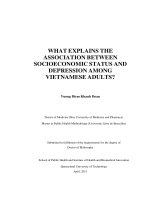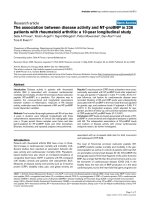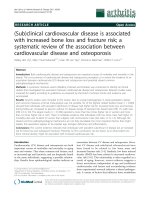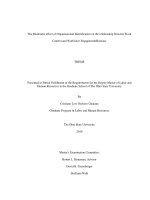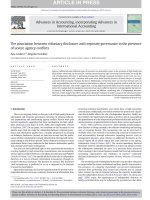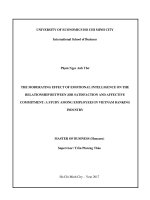Single-base-resolution methylomes of populus trichocarpa reveal the association between DNA methylation and drought stress
Bạn đang xem bản rút gọn của tài liệu. Xem và tải ngay bản đầy đủ của tài liệu tại đây (1.28 MB, 11 trang )
Liang et al. BMC Genetics 2014, 15(Suppl 1):S9
/>
PROCEEDINGS
Open Access
Single-base-resolution methylomes of populus
trichocarpa reveal the association between DNA
methylation and drought stress
Dan Liang1†, Zhoujia Zhang1†, Honglong Wu3†, Chunyu Huang2†, Peng Shuai1†, Chu-Yu Ye1, Sha Tang1,
Yunjie Wang2, Ling Yang3, Jun Wang2, Weilun Yin1*, Xinli Xia1*
From International Symposium on Quantitative Genetics and Genomics of Woody Plants
Nantong, China. 16-18 August 2013
Abstract
Background: DNA methylation is an important biological form of epigenetic modification, playing key roles in
plant development and environmental responses.
Results: In this study, we examined single-base resolution methylomes of Populus under control and drought
stress conditions using high-throughput bisulfite sequencing for the first time. Our data showed methylation levels
of methylated cytosines, upstream 2kp, downstream 2kb, and repeatitive sequences significantly increased after
drought treatment in Populus. Interestingly, methylation in 100 bp upstream of the transcriptional start site (TSS)
repressed gene expression, while methylations in 100-2000bp upstream of TSS and within the gene body were
positively associated with gene expression. Integrated with the transcriptomic data, we found that all cis-splicing
genes were non-methylated, suggesting that DNA methylation may not associate with cis-splicing. However, our
results showed that 80% of trans-splicing genes were methylated. Moreover, we found 1156 transcription factors
(TFs) with reduced methylation and expression levels and 690 TFs with increased methylation and expression levels
after drought treatment. These TFs may play important roles in Populus drought stress responses through the
changes of DNA methylation.
Conclusions: These findings may provide valuable new insight into our understanding of the interaction between
gene expression and methylation of drought responses in Populus.
Background
Populus (Populus sp.) is an ideal model system for investigating molecular mechanisms of trees in response to
environmental stresses, due to its advantages including
rapid growth, high yield, easy propagation, importance in
the economy and available genomic resources [1,2].
Drought is a major abiotic stress that limits the survival
and growth of young poplar plants [3]. Therefore, many
* Correspondence: ;
† Contributed equally
1
College of Biological Sciences and Technology, National Engineering
Laboratory for Tree Breeding, Beijing Forestry University, Beijing 100083,
China
Full list of author information is available at the end of the article
studies have focused on understanding drought responsive
mechanisms in Populus [4-6].
DNA methylation is an important biological form of
epigenetic modification. Currently, methylation analysis
is widely used to explore various mechanisms underlying
biological survival in plants [7,8], humans [9], and insects
[10]. Plant genomes show extensive cytosine methylation
at CG, CNG (N represents any nucleotide), and CHH (H
represents A, C or T) sites [11]. Previous studies indicated that the effect of DNA methylation in plants refers
to DNA methylation preventing DNA transcription by
combining with the genomic sequence of transcription
factors, and another refers to specific proteins (known as
methyl-CpG binding proteins) binding with methylated
DNA and acting as competitors of transcription factors.
© 2014 Liang et al.; licensee BioMed Central Ltd. This is an Open Access article distributed under the terms of the Creative Commons
Attribution License ( which permits unrestricted use, distribution, and reproduction in
any medium, provided the original work is properly cited. The Creative Commons Public Domain Dedication waiver (http://
creativecommons.org/publicdomain/zero/1.0/) applies to the data made available in this article, unless otherwise stated.
Liang et al. BMC Genetics 2014, 15(Suppl 1):S9
/>
Complexes of proteins affect chromosome histone acetylation, leading to transcriptional inhibition [12,13].
Methylation induced by biotic stress is generally associated with the silencing of parasitic DNA and expression
of resistant genes, while abiotic stress-induced methylation is supposed to be linked with the transcription factors which participate in numerous biochemical
pathways involved in acclimatization and stress response
in plants [14].
Numerous studies have shown that DNA methylation
levels could be affected by plant stress in Arabidopsis,
rice, pea and other plants [15-18], but few about trees.
Uthup et al. have reported the identification of DNA
methylation patterns and their putative relationship with
abiotic stress in the tree crop Hevea brasiliensis [14]. The
percentage of hypermethylated loci increased, and that of
fully methylated loci clearly decreased in Quercus ilex
trees exposed to drought [19]. However, no studies performed methylation analysis of Populus at the genomic
level under drought stress by using high-throughput
bisulfite sequencing. To improve our understanding of
the resistance mechanisms at the molecular level in
Populus, we investigated DNA methylomes of Populus
trichocarpa under normal and drought conditions, focusing on epigenetic regulation of stress responses.
Results
Bisulfite sequencing of the Populus trichocarpa genome
To generate the single-base resolution methylome of
P. trichocarpa under normal (i.e., well water; WW) and
drought stress (i.e., water stress; WS) conditions, we
applied the Illumina Hiseq 2000 platform for bisulfite
sequencing of DNA extracted from leaves. Reads that
aligned to the unmethylated lambda DNA, which were
added to the total DNA before applying the bisulfite treatment, were used to calculate the conversion rate. The conversion rates of WW and WS were 99.40% and 99.45%,
respectively. Two sets of raw data were obtained from
sequencing, with the output of 16.86 giga base pair (Gb) in
WW sample and 16.63 Gb in WS. We subsequently used
a series of filter criteria to ensure the data quality, including trimming low-quality reads(reads that contain more
than 50% unknown bases) and retaining unique-aligned
reads. Finally, 72.96% of the reads in WW and 76.69% of
the reads in WS were used for further analysis. These data
were estimated to cover the whole genome with 28.45and 29.93-fold sequencing depths (Additional file 1). To
avoid the effects of individual SNPs, the online original
reference ( />html) was modified by the resequence data.
DNA methylation in Populus trichocarpa
Our results showed that methylated cytosines (mCs)
accounting for 10.04% of all cytosines in the whole
Page 2 of 11
genome under drought stress were significantly more
than those (7.75 %) in WW (Additional file 2). Distribution of cytosine methylation levels showed that more
proportions of mCG and mCHG have higher methylation levels as compared with mCHH (Figure 1-a). CG
sites were much higher methylated in gene region than
other sites (Figure 1-b). Additionally, our results showed
that methylated sites were concentrated in the non-CG
sites in the Populus genome, especially in mCHH
(Figure 1-c), and the basic group of HH or mCHH tended
to contain twofold more A or T (Additional file 3). Since
the chromosome structure of the P. trichocarpa genome is
imperfect, we concatenated the remaining fragments as
the 20th scaffold in addition to the existing 19 scaffolds
and then analyzed the distribution of the mCs across chromosomes, which shows that there was a high methylated
cytosine density in centromere regions that consisted of
more repetitive sequences (Additional file 4).
The following analysis was to investigate the methylation
profiles of coding sequences (CDSs), introns, untranslated regions (UTRs), small RNAs, repetitive DNAs
under relative and absolute methylation standards [10].
We found that methylation levels in coding regions were
higher than that in 5’- and 3’-UTRs. The methylation
levels of repetitive regions were significantly higher than
those of gene body regions (p < 7.71E-07, Wilcoxon
RankSum test). Furthermore, the methylation levels of
2000bp upstream of the transcriptional start site (up2K),
2000bp downstream of the transcriptional termination
site (down2K), and repetitive sequences were significantly
higher after drought treatment (p < 0.001625, Wilcoxon
RankSum test) (Figure 2).
Gene Ontology analysis demonstrated biological processes related to biological regulation were enriched in
both newly methylated and demethylated genes after
drought stress as compared with the whole Populus genome, indicating that methylation or demethylation of
these biological regulation related genes may play important roles in drought stress response of Populus (Additional file 5-a,b).
Prediction and validation of splicing events in
P. trichocarpa
We used transcriptome sequencing technology to further
investigate the expression profiles of two samples (i.e.,
WW and WS). A total of 130,884,860 and 138,441,434
raw reads were generated, and 86,385,459 (66.00%) and
90,236,283 (65.18%) unique alignment reads were
retained in WW and WS, respectively (Additional file 6).
We analyzed two splicing forms of the genes, i.e., the
trans-splicing and cis-splicing models. Cis-splicing occurs
within a single transcript, which can produce multiple
mRNA transcripts. Trans-splicing occurs at the bonding
point, which is formed by two different genes [26].
Liang et al. BMC Genetics 2014, 15(Suppl 1):S9
/>
Page 3 of 11
Figure 1 The global pattern of Populus DNA methylomes. (a) The percentage of methylated cytosines distribution in each sequence context
(H=A, T, C). The y axis indicates the percentage methylated cytosines according to each methylation level which show on x axis.(methylation
level = # of mC / # of C * 100%) (b) Distribution of CG, CHG and CHH methylation levels in each sequence context of gene related region,
including upstream, first exon, first intron, internal exon, internal intron, last exon and downstream.. The x axis shows seven elements, the y axis
represents average methylation levels of cytosines. The red dots represent average methylation levels of bins, the curve shows the average value
of 5 bins with 1-bin step, and the green dotted line indicate TSSs (transcription start sites) (c) The percentage and absolute number of
methylated cytosines that identified in WW(left) and WS(right) in each sequence context.
Liang et al. BMC Genetics 2014, 15(Suppl 1):S9
/>
Page 4 of 11
Recently, alternative splicing and gene fusion were discovered by high-throughput sequencing in more species,
such as human [27], rice [24] and Arabidopsis[28].
However, no information on alternative splicing in Populus was available. We found four alternative splicing
types in P. trichocarpa: A) Exon skipping, B) intron
retention, C) alternative 5 ‘splice sites, and D) alternative
3’ splice sites, according to the classification of alternative
splicing types in rice [24] and 11791 and 13251 alternative splicing genes in WW and WS, respectively. At least
20% of intron-containing genes in P. trichocarpa were
spliced, which is lower than that (42%) in Arabidopsis
[28]. More genes in WS were alternatively spliced in four
alternative splicing types (Figure 3), especially the alternative 3’ splice sites were more increased, suggesting that
alternative splicing can be regulated and associated with
environmental stress as previous reports [29,30] and
methylation may play more acting on alternative 3’ splice
sites after drought treatment in Populus. Particularly, in
terms of the methylation level of 20 bp sequences containing alternative splicing sites, more than 80% of all
alternative splicing sites in two samples were non-methylated, while none of the genes were methylated (Additional file 7-a). Interestingly, we found that 80% of the
fusion genes were methylated and the splicing events
were decreased after the drought treatment (Table 1). To
verify the accuracy of the fusion gene, that identified 227
and 161 in WW and WS, we randomly selected 10 genes
in the two groups of fusion materials to test by RT-PCR,
six of which were verified (Additional file 7-b). The probability (6/10) was slightly lower than expected based on
the accuracies in human and rice [24,27].
Effects of DNA methylation on gene expression in
P. trichocarpa
To compare the effects of Populus DNA methylation on
gene expression in two samples (i.e., WW and WS), we
used transcriptome sequencing to determine the expression levels of methylated and unmethylated genes. Generally speaking, the expression levels of examined 17714
expressed genes were positively correlated with their
methylation levels. We found that 7392 genes exhibited
rising trends in methylation and expression levels after
drought treatment. Methylation and expression levels
were both reduced in 10322 genes under drought stress.
To further analyze the relationship between gene
expression and methylation levels, we divided these
genes into four categories based on expression levels:
High expression, medium expression, low expression,
and silent genes, from the bottom one-third to the top
one-third (Figure 4-a). We found that silent genes had
significantly higher methylation levels than expressed
genes, indicating that gene silence may be caused by
high methylation level (p = 6.8E-08, Wilcoxon Rank
Sum test). For expressed genes, methylation levels in
gene body and upstream region were positively correlated with gene expression (Additional file 8). Nonetheless, gene expression levels had negative correlations
with methylation at transcription start sites (TSSs), transcriptional termination regions (TTRs) and downstream
regions.
Gene-body methylation genes had significantly higher
expression levels than body-unmethylated genes (p =
6.01E-07, Wilcoxon rank sum test) indicating a positive
correlation between gene expression and gene-body
methylation (Figure 4-c). Interestingly, the results
showed that upstream2k-methylated genes have significantly higher expression level than upstream 2kunmethylated genes (p = 7.41E-05, Wilcoxon rank sum
test) [31] (Figure 4-d). However, further analysis was
performed on the 100bp upstream of the transcriptional
start site (TSS), and found that genes methylated in this
region had significantly higher expression level than
unmethylated genes (p = 8.6E-06, Wilcoxon rank sum
test), indicating that methylation of this region induced
gene expression (Figure 4-e). Coincident with the situation of 100 bp upstream of the TSS, downstream2kunmethylated genes have higher expression level than
downstream2k-methylated genes (Figure 4-f).
As regards changes after drought treatment, the methylation levels of the silent genes increased significantly
(p = 6.796E-08, Wilcoxon rank sum test) (Figure 4-a,b).
The expression level of upstream2k-unmethylated genes
was reduced, while it increased for genes methylated in
100bp upstream of TSS. Downstream2k-unmethylated
genes have higher expression level after treatment. Genebody methylated and unmethylated genes have no significant change.
Differentially expressed and methylated transcription
factors
Due to critical roles of transcription factors (TFs) in
responses to external stimuli by influencing the expression of downstream targets, we identified differentially
Table 1 Numbers of methylated and unmethylated gene fusions.
Sample Methylated genes in the
genome
Unmethylated genes in
the genome
Fusion genes both
methylated
Fusion genes both
unmethylated
Fusion genes one
methylated
WW
23983
8071
194
4
29
WS
22498
8895
130
11
20
Liang et al. BMC Genetics 2014, 15(Suppl 1):S9
/>
expressed and methylated TFs in P. trichocarpa according to two TF databases (i.e., DPTF (.
edu.cn/index.php) [32] and PlnTFDB (.
uni-potsdam.de/v3.0/) [33]. A total of 1156 TFs showed
reduced methylation and expression levels after drought
treatment. These TFs were distributed in 79 families,
including MYB, AP2, WRKY, NAC, and bHLH. We also
found that 690 TFs showed increased methylation and
expression levels after drought treatment. Most of them
belong to C3H, PHD, MYB, ARF, and bZIP families
(Additional file 9).
Transposable elements (TEs) can influence gene regulation on a genomic scale by carrying potential transcription-regulating signals. To further analyze the
mechanism underlying the TF response to drought
stress by hypermethylation of transposons, we found
389 and 334 TFs were located by TEs in promoters and
in gene bodies using the described method by Thornburg [34], respectively. The methylation levels of 138
TEs in promoters were elevated by drought treatment,
while those of 251 TEs were reduced. The methylation
levels of 163 TEs in gene body regions were elevated
under drought treatment, while those of 171 TEs were
reduced. These two kind of transcription factors were
divided into 64 and 60 families (Additional file 10, 11),
respectively, which were concentrated in both the major
transcription factor families and some related to stress
signal transduction, such as C2C2 and EIL proteins.
Disscussion
Although the relationship between DNA methylation
and gene expression has been explored in Populus and
other plants [35,36], the resolution of genome-wide
methylated cytosines requires more elaborate and comprehensive methylomic studies to characterize the functional effects of Populus DNA methylation. We obtained
the single-base resolution methylomes of Populus, which
was used to investigate the changes of DNA methylation
under drought treatment via the high-throughput
sequencing, and found the genome-wide methylation
level in P. trichocarpa was slightly higher than that in
Arabidopsis [24] but lower than humans [9]. Moreover,
having found plausible patterns with our comprehensive
dataset, our results have a number of implications,
which will have a promising application in the future
research on Populus and may give some cue on other
plants’ studies.
The relationship of methylation and splicing events in
P. trichocarpa
The role of DNA methylation in alternative splicing is
supported by Shukla et al. [37] in CD45 cells, as well as
by Chodavarapu et al. in Arabidopsis thaliana, showing
that DNA methylation is highly enriched in exons and
Page 5 of 11
may have an important role in alternative splicing [38].
We did not find any methylated sites in more than 80%
of alternative splicing genes. In contrast with the previous results, DNA methylation is not enriched in exons
and the methylation levels in exons were not significant
higher than the other regions in Populus. Therefore, our
results can’t speculate that DNA methylation may play
an important role in alternative splicing in Populus genome. By contrast, our results showed that all fusion
genes were methylated, that inferred that this phenomenon might be associated with the mechanisms of two
different splicing forms. Methylation may not affect the
enzymatic reaction that results in alternative splicing,
but can affect chromosomal rearrangements, RNA editing and other structural variations what might cause the
occurrence of gene fusion.
Drought treatment has different effects on two different splicing forms, the number of genes with alternative
splicing events was increased, while fusion genes were
reduced after the drought treatment. Since the effects of
drought on the complex network of signaling pathway
in Populus, we can not point out the direct cause, but it
can be speculated that it may be related to the formation or activity of cleavage enzyme, which main activates
at 3 ‘ and 5 ‘ two positions.
DNA methylation and gene expression
The way of the expression of genes affected by DNA
methylation in plant is combining with specific protein,
which competes with transcription factors. The complex
causes the changes in chromosome histone acetylation,
leading to the inhibition of transcription, that point was
more prominent in poplar. In Populus, about 60% of
silent genes were affected by methylation. After the
drought treatment, the probability was increased, indicating that the influence of gene expression by methylation increased with the external environmental stimuli.
For expressed genes, methylation in 100 bp upstream
of the TSS represses gene expression, which is consistent
with the findings from A. thaliana[39], human [9] and
rice [40], confirming that neighbouring upstream of TSS
methylation is a general mechanism suppressing gene
expression in eukaryotes. However, we found that methylation level in 100-2000 bp upstream was positively correlated with gene expression. It is interesting that the
expression of genes methylated in 100bp upstream of
TSS were affected after the drought treatment, which
indicated that drought treatment reduced the chances of
combining with specific protein and increased levels of
gene expression. In the TTR (transcriptional termination
regions) and the downstream region, methylation and
expression were negatively correlated, indicating that
they had significant effect on gene expression through
interfering with transcriptional termination site.
Liang et al. BMC Genetics 2014, 15(Suppl 1):S9
/>
Drought is one of the major environmental factors that
affected gene expression by complex signaling networks,
including cytosine methylation, histone acetylation and
H3K9 methylation [17]. In Populus, the expression of gene
was affected by drought on genetic elements in upstream
and downstream. Combined with changes in methylation
levels, 100 bp upstream of the TSS was focused. To further
understand the relationship between methylation and
drought, we need to make sure the genetic elements in different locations of upstream.
Methylated transcription factors with TE in drought
tolerance
Transcription factors involved in signal transduction
related to various stresses, such as drought. Diverse biological activities were regulated directly or indirectly by
these transcription factors. The demethylation of transcription factors under drought stress may reduce the stability of the gene, thereby affecting its expression. (For
example, BZIP, WRKY, AP2 / EREBP and MYB, four
major transcription factor families, play an important role
in plant stress resistance, and many TFs of expression
changed by methylation in our results also belong to
them).
The use of transposable elements (TEs) for reverse
transcription, DNA cutting and ligation or DNA binding
are well-documented [41]. Changes in transposition
activity correlated with methylation were first described
in maize [42,43]. Subsequently, in both plants and animals [44], the role of DNA methylation in transposons
was directly tested by loss of DNA methylation (which is
sufficient for the mobilization of transposons) [45]. TEs
can influence gene regulation on a genomic scale by carrying potential transcription-regulating signals. When
inserted in promoter regions, they can alter gene expression patterns by introducing new transcription factor
binding sites [46]. Our data indicated that transcription
factors that affect gene expression after drought treatment were affected by methylated transposons in
Populus. We found methylated transposons in C2C2,
WRKY MYB and other families that involved in signal
transduction pathway of drought. When the environment
changes, transposition frequency in plants increased. TEs
were inserted into positive transcription factors and promoted expression, consequently increasing the expression of resistance genes. Insertion in some locations
could inhibit the expression of positive transcription
factors and decrease the resistance of a gene (such as
by insertion of a negative transcription factor), which
may have the opposite effect. Analysis of methylated
transposons in transcription factors may increase our
understanding of the specific mechanisms by which transcription factors regulate the stress response in plants.
Page 6 of 11
Conclusions
In this study, genome-wide DNA methylation sequencing of poplar leaves with WW and WS treatments
were established using high-throughput technology. It
confirmed that cis-splicing sites are unmethylated, while
trans-splicing sites are methylated in poplar, to our
knowledge this is the first report of an association
between methylation and variable splicing. It further
demonstrated that DNA methylation in the regulation
of stress-responsive genes by identifying methylated
transposable elements (TEs) in promoters and the gene
body of transcription factors. Finally, the mechanism
that the DNA methylation played on the gene expression, alternative splicing, and other phenomenon was
still unclear based on current technology and experiment condition, otherwise our study pave the way for
future discovering of methylation-associated mechanism
in large-scale integrative multi-omics datasets.
Methods
Plant materials
Populus trichocarpa (Torr. & Gray) seedlings were
planted separately into 10-L plastic pots filled with a mixture of clay, silt and sand (2:2:2, v/v). They were grown
under well-watered (WW) conditions in a greenhouse at
Beijing Forestry University for 2 months. The plants were
supplemented with light for 15 h d-1, and temperature
and humidity were kept constant. According to previous
reports [20-22], the plantlets were divided into two
groups, which were subjected to the following watering
regimes: well-watered (WW) treatment (maintaining
100% of field capacity) and water-stress (WS) treatment
(maintaining 25% of field capacity). Volumetric soil water
content was kept at 24% in the WW treatment, while in
the WS treatment the volumetric soil water content was
kept at approximately 10%. Net photosynthetic rate, transpiration rate and leaf water potential (WP) were measured using the PsyPro WP data logger (Wescor) and Li6400 Photosynthesis System (Li-Cor). After 5 weeks,
plants of similar height (~75 cm) were selected for the
experiment. Five replicates (four plantlets per replicate)
were used to minimize random errors. Mature leaves
from the same position (8-10th counting from the apex)
of different individual plants were collected and frozen
immediately in liquid nitrogen for DNA extraction.
BS-Seq libraries construction and sequencing
Total DNA was extracted from the leaves collected from
our experiment. Total DNA was prepared by proteinase
K/phenol extraction following the manufacturer’s
instructions. The DNA was fragmented by sonication
using a Bioruptor (Diagenode, Belgium) to a mean size
of ~250 bp, followed by the blunt ending, dA addition
Liang et al. BMC Genetics 2014, 15(Suppl 1):S9
/>
to 3’-end, and adaptor addition following the manufacturer’s protocol. The bisulfite conversion of the adaptoradded DNA was performed as described previously [23].
Ultra-high-throughput pair-end sequencing was performed using the Hiseq 2000 according to the manufacturer’s instructions. Raw data were processed using
Illumina base-calling pipeline.
Page 7 of 11
control was calculated following the formula: p = 1 (# of methylated cytosines) / (# of cytosines). Using this
value as a measure of the false mC discovery rate, mC
was identified at each base position according to the
binomial probability distribution, following the correction algorithm of Lister et al. [9].
Transcriptome sequencing
Mapping and processing of BS-Seq reads
Integrated with the Populus reference (v2.0) and resequencing data, we constructed a consensus sequence as a
reference to align the methylation data. Because the
strand-specific of methylation, two artificial genomes
were construct, the T genome that whose cytosines had
been converted to thymines and the A genome whose
guanines had been converted to adenosines. After removing the low quality reads, all cytosines of reads1 were
converted to thymines and all guanines of reads2 were
converted to adenosines, and then all these reads were
aligned to the T genome and A genome using SOAPaligner (v2.01) software with parameters -m 175 -x 325 -v
(default 2), respectively. To increase the accuracy of
methylation related analysis, reads that aligned to more
than one positions were discarded.
All the unmethylated cytosine can be converted from
cytosine to thymine during the process of bisulfite conversion, but the methylated cytosine will be the same. To
remove the methylcytosines from the background noise
which cause by the non-conversion of bisulfite, we use
the conversion rate of lambda DNA input as a negative
For the synthesis of cDNA and Solexa sequencing, we prepared 45 μg of total RNA for treated and control sample at
concentrations of approximately 1500 ng/μl. We then
enriched the poly (A) mRNA using beads with Oligo (dT)
and interrupted mRNA into short fragments with fragmentation buffer. Using these short fragments as templates, we
synthesized first-strand cDNA with hexamer-primers and
reverse transcriptase (Invitrogen). The second-strand
cDNA was synthesized using buffer, dNTPs, RNaseH (Invitrogen) and DNA polymerase I (New England BioLabs).
The short fragments were then purified using a QiaQuick
PCR extraction kit and re- solved with EB buffer to finish
the end reparation, and was connected using sequencing
adaptors. After resolution by agarose gel electrophoresis,
we selected fragments suitable for PCR amplification. We
then constructed two paired-end libraries which were
sequenced using an Illumina HiSeq 2000.
Prediction of splicing events
The pair-end reads that aligned to two different genes
were considered candidate fusion genes. To ensure the
accuracy of detecting the fusion genes, PE reads that
Figure 2 Relative methylation levels of the corresponding genomic region. The y axis shows the relative methylation level in each element
of genomic region (x axis), which contains upstream, 5’ UTR, CDS, Intron, 3’ UTR, Downstream and repeative sequences.
Liang et al. BMC Genetics 2014, 15(Suppl 1):S9
/>
Page 8 of 11
Figure 3 The Histogram chart of alternative splicing events and genes identified in WW and WS. The green columns indicate the
number of alternative splicing events and the red columns show the total number of gene in each events.
aligned to more than one location were discarded. Junction sequences were obtained by combining the exons
of candidate genes. Junction reads and PE reads having
only one end were compared to reference genes (5-bp
overlap at least on the fusion point), and the candidate
genes were supported by both PE reads and junction
reads. The homologous candidate genes were detected
and excluded, and the identification of alternative splicing sites was performed as described previously [24].
Collected potential splice sites by enumerating all possible pairs of donor sites (GT on the forward strand and
AC on the reverse strand) and acceptor sites (AG on
the forward strand and CT on the reverse strand) inside
intron regions. Secondly, filtered all potential splice sites
through the information of supported reads. At least
two unique mapped reads convered on the junction site
and having a minimum of five bases on both sides of
the junction. Finally, categorized all these splice sites
into seven types including exon skipping (ES), intron
retention (IR), alternative 5’ splice site (A5SS), alternative 3’ splice site (A3SS), mutually exclusive exons
(MXE), alternative first exons (AFE), and alternative last
exons (ALE).
Gene ontology (GO) analysis
GO annotations of poplar genes were downloaded from
( />GO comparative analyses between interested gene groups
were performed using BGI WEGO (omics.
org.cn/cgi-bin/wego/index.pl). GO enrichment analysis was
Liang et al. BMC Genetics 2014, 15(Suppl 1):S9
/>
Page 9 of 11
Figure 4 The relationship between methylation level and gene expression. (a) The methylation level trend (y axis) of four different gene
clusters (High, medium, low, and silent genes, from the bottom one-third to the top one-third and non-expressed according to Transcriptome
Sequencing data) in gene-associated region(x axis) in WW. (b) The methylation level trend (y axis) of four different gene clusters in geneassociated region(x axis) in WS (c) Distribution of methylated and unmethylated gene expression levels in gene-body. The horizontal axis
represents expression level, and the vertical axis represents the percentage of genes on a particular expression level. (d) Distribution of
methylated and unmethylated gene expression levels in upstream2k. (e) Distribution of methylated and unmethylated gene expression levels in
100bp upstream of the TSS. (f) Distribution of methylated and unmethylated gene expression levels in downstream2k.
performed using Blast2GO and agriGO (.
edu.cn/agriGO/) with Fisher’s exact test [25].
correlation(y-axis) between methylation and expression. Red line stands
for WW and blue line stands for WS.
Additional file 9: Category of co-regulated transcription factors
Additional material
Additional file 1: Description of the data for the Populus of two
treatments
Additional file 10: Category of transcription factors with methylated
TE that located in promoter
Additional file 11: Category of transcription factors with methylated
TE that located in gene
Additional file 2: Three methylation patterns of Populus
Additional file 3: Seqlogo of the sequences proximal to DNA
methylation cytosines. One stack for each position in these two
sequence contexts (CHG, CHH), The overall height of the stack indicates
the sequence conservation at that position, while the height of bases
within the stack indicates the relative frequency of each base at that
position. (red = T, green = A, blue = C, yellow = G)
Additional file 4: Density of methylcytosines identified in each
chromosome in Populus. Red dots indicate the density of all
methylcytosines in 10 kb windows. The top panel shows the Watson
strand information and the bottom panel displays crick strand
information.
Additional file 5: GO enrichment analysis newly methylated and
demethylated genes.
Additional file 6: Description of the data for the Populus of two
treatments by Transcriptome Sequencing
Additional file 7: Results of two splicing forms. (a) Four kinds of
alternative splicing types were compared to each other on methylation
level; (b) the PCR result of the fusion genes verification.
Additional file 8: The correlation between gene methylation and
gene expression. The upstream, gene body and downstream were split
into 20 bins that lay on x-axis for investigating the spearman rank
Competing interests
The authors declare that they have no competing interests.
Authors’ contributions
DL PS designed and conducted the experiments, DL HL CH PS ZZ ST
analyzed the data, DL HLPS WY XX drafted the manuscript, WY XX
supervised the project. All authors have read and approved the final version
of this manuscript.
Declarations
Publication charges for this work were supported by the National Natural
Science Foundation of China (31070597, 31270656), the fund from the
Ministry of Science and Technology of China (2009CB119101), and the
Scientific Research and Graduate Training Joint Programs from BMEC (Stress
Tolerance and DNA Methylation in Populus).
This article has been published as part of BMC Genetics Volume 15
Supplement 1, 2014: Selected articles from the International Symposium on
Quantitative Genetics and Genomics of Woody Plants. The full contents of
the supplement are available online at />bmcgenet/supplements/15/S1.
Liang et al. BMC Genetics 2014, 15(Suppl 1):S9
/>
Authors’ details
1
College of Biological Sciences and Technology, National Engineering
Laboratory for Tree Breeding, Beijing Forestry University, Beijing 100083,
China. 2BGI-Shenzhen, Building 11, Beishan Industrial Zone, Yantian District,
Shenzhen, Guangdong, China. 3BGI-Tianjin, E3 building, Airport Business Park,
Tianjin Airport Economic Area,Tianjin, China.
Published: 20 June 2014
References
1. Jansson S, Douglas CJ: Populus: a model system for plant biology. Annu
Rev Plant Biol 2007, 58:435-458.
2. Tuskan GA, Difazio S, Jansson S, Bohlmann J, Grigoriev I, Hellsten U,
Putnam N, Ralph S, Rombauts S, Salamov A, et al: The genome of black
cottonwood, Populus trichocarpa (Torr. & Gray). Science 2006,
313(5793):1596-1604.
3. Tuskan GA: Short-rotation woody crop supply systems in the United
States: what do we know and what do we need to know? Biomass and
Bioenergy 1998, 14(4):307-315.
4. Bogeat-Triboulot MB, Brosche M, Renaut J, Jouve L, Le Thiec D, Fayyaz P,
Vinocur B, Witters E, Laukens K, Teichmann T, et al: Gradual soil water
depletion results in reversible changes of gene expression, protein
profiles, ecophysiology, and growth performance in Populus euphratica,
a poplar growing in arid regions. Plant physiology 2007, 143(2):876-892.
5. Tang S, Liang H, Yan D, Zhao Y, Han X, Carlson J, Xia X, Yin W: Populus
euphratica: the transcriptomic response to drought stress. Plant Mol Biol
2013, 1-19.
6. Shuai P, Liang D, Zhang Z, Yin W, Xia X: Identification of droughtresponsive and novel Populus trichocarpa microRNAs by highthroughput sequencing and their targets using degradome analysis.
Bmc Genomics 2013, 14(1):233.
7. Lister R, O’Malley RC, Tonti-Filippini J, Gregory BD, Berry CC, Millar AH,
Ecker JR: Highly integrated single-base resolution maps of the
epigenome in Arabidopsis. Cell 2008, 133(3):523-536.
8. Wang X, Elling AA, Li X, Li N, Peng Z, He G, Sun H, Qi Y, Liu XS, Deng XW:
Genome-Wide and Organ-Specific Landscapes of Epigenetic
Modifications and Their Relationships to mRNA and Small RNA
Transcriptomes in Maize. The Plant Cell Online 2009, 21(4):1053-1069.
9. Lister R, Pelizzola M, Dowen RH, Hawkins RD, Hon G, Tonti-Filippini J,
Nery JR, Lee L, Ye Z, Ngo QM, et al: Human DNA methylomes at base
resolution show widespread epigenomic differences. Nature 2009,
462(7271):315-322.
10. Xiang H, Zhu J, Chen Q, Dai F, Li X, Li M, Zhang H, Zhang G, Li D, Dong Y,
et al: Single base-resolution methylome of the silkworm reveals a sparse
epigenomic map. Nature biotechnology 2010, 28(5):516-520.
11. Cao X, Jacobsen SE: Locus-specific control of asymmetric and CpNpG
methylation by the DRM and CMT3 methyltransferase genes. Proceedings
of the National Academy of Sciences 2002, 99(Suppl 4):16491-16498.
12. Razin A: CpG methylation, chromatin structure and gene silencing-a
three-way connection. The EMBO journal 1998, 17(17):4905-4908.
13. Curradi M, Izzo A, Badaracco G, Landsberger N: Molecular mechanisms of
gene silencing mediated by DNA methylation. Molecular and cellular
biology 2002, 22(9):3157-3173.
14. Uthup TK, Ravindran M, Bini K, Thakurdas S: Divergent DNA Methylation
Patterns Associated with Abiotic Stress in Hevea brasiliensis. Molecular
Plant 2011, 4(6):996-1013.
15. Labra M, Ghiani A, Citterio S, Sgorbati S, Sala F, Vannini C, RuffiniCastiglione M, Bracale M: Analysis of Cytosine Methylation Pattern in
Response to Water Deficit in Pea Root Tips. Plant Biology 2002,
4(6):694-699.
16. Colaneri AC, Jones AM: Genome-Wide Quantitative Identification of DNA
Differentially Methylated Sites in Arabidopsis Seedlings Growing at
Different Water Potential. PloS one 2013, 8(4):e59878.
17. Wang W-S, Pan Y-J, Zhao X-Q, Dwivedi D, Zhu L-H, Ali J, Fu B-Y, Li Z-K:
Drought-induced site-specific DNA methylation and its association with
drought tolerance in rice (Oryza sativa L.). Journal of experimental botany
2010.
18. Yu Y, Yang X, Wang H, Shi F, Liu Y, Liu J, Li L, Wang D, Liu B:
Cytosine Methylation Alteration in Natural Populations of Leymus
chinensis Induced by Multiple Abiotic Stresses. PloS one 2013, 8(2):
e55772.
Page 10 of 11
19. Rico L, Ogaya R, Barbeta A, Peñuelas J: Changes in DNA methylation
fingerprint of Quercus ilex trees in response to experimental field
drought simulating projected climate change. Plant Biol (Stuttg) 2013,
16(2):419-427.
20. Griffiths H, Parry MA: Plant responses to water stress. Annals of Botany
2002, , 89: 801-802.
21. Xu X, Yang F, Xiao X, Zhang S, Korpelainen H, Li C: Sex-specific responses
of Populus cathayana to drought and elevated temperatures. Plant, cell &
environment 2008, 31(6):850-860.
22. Regier N, Streb S, Cocozza C, Schaub M, Cherubini P, Zeeman SC, Frey B:
Drought tolerance of two black poplar (Populus nigra L.) clones:
contribution of carbohydrates and oxidative stress defence. Plant, cell &
environment 2009, 32(12):1724-1736.
23. Hayatsu H, Tsuji K, Negishi K: Does urea promote the bisulfite-mediated
deamination of cytosine in DNA? Investigation aiming at speeding-up
the procedure for DNA methylation analysis. Nucleic Acids Symposium
Series 2006, 50(1):69-70.
24. Zhang GJ, Guo GW, Hu XD, Zhang Y, Li QY, Li RQ, Zhuang RH, Lu ZK,
He ZQ, Fang XD: Deep RNA sequencing at single base-pair resolution
reveals high complexity of the rice transcriptome. Genome research 2010,
20(5):646-654.
25. Du Z, Zhou X, Ling Y, Zhang Z, Su Z: agriGO: a GO analysis toolkit for the
agricultural community. Nucleic acids research 2010, 38(suppl 2):W64-W70.
26. Horiuchi T, Aigaki T: Alternative trans-splicing: a novel mode of premRNA processing. Biology of the Cell 2006, 98(2):135-140.
27. Akiva P, Toporik A, Edelheit S, Peretz Y, Diber A, Shemesh R, Novik A,
Sorek R: Transcription-mediated gene fusion in the human genome.
Genome research 2006, 16(1):30-36.
28. Filichkin SA, Priest HD, Givan SA, Shen R, Bryant DW, Fox SE, Wong WK,
Mockler TC: Genome-wide mapping of alternative splicing in Arabidopsis
thaliana. Genome research 2010, 20(1):45-58.
29. Mazzucotelli E, Mastrangelo AA, Crosatti C, Guerra D, Stanca AM, Cattivelli L:
Abiotic stress response in plants: When post-transcriptional and posttranslational regulations control transcription. Plant Sci 2008,
174(4):420-431.
30. Palusa SG, Ali GS, Reddy ASN: Alternative splicing of pre-mRNAs of
Arabidopsis serine/arginine-rich proteins: regulation by hormones and
stresses. The Plant Journal 2007, 49(6):1091-1107.
31. Li X, Wang X, He K, Ma Y, Su N, He H, Stolc V, Tongprasit W, Jin W, Jiang J:
High-Resolution Mapping of Epigenetic Modifications of the Rice
Genome Uncovers Interplay between DNA Methylation, Histone
Methylation, and Gene Expression. The Plant Cell Online 2008,
20(2):259-276.
32. Zemach A, McDaniel IE, Silva P, Zilberman D: Genome-wide evolutionary
analysis of eukaryotic DNA methylation. Science 2010, 328(5980):916-919.
33. Perez-Rodriguez P, Riano-Pachon DM, Correa LG, Rensing SA, Kersten B,
Mueller-Roeber B: PlnTFDB: updated content and new features of the
plant transcription factor database. Nucleic acids research 2010,
38(Database):D822-827.
34. Thornburg BG, Gotea V, Makalowski W: Transposable elements as a
significant source of transcription regulating signals. Gene 2006,
365:104-110.
35. Vining KJ, Pomraning KR, Wilhelm LJ, Priest HD, Pellegrini M, Mockler TC,
Freitag M, Strauss SH: Dynamic DNA cytosine methylation in the Populus
trichocarpa genome: tissue-level variation and relationship to gene
expression. Bmc Genomics 2012, 13:27.
36. Li XY, Wang XF, He K, Ma YQ, Su N, He H, Stolc V, Tongprasit W, Jin WW,
Jiang JM, et al: High-resolution mapping of epigenetic modifications of
the rice genome uncovers interplay between DNA methylation, histone
methylation, and gene expression. Plant Cell 2008, 20(2):259-276.
37. Shukla S, Kavak E, Gregory M, Imashimizu M, Shutinoski B, Kashlev M,
Oberdoerffer P, Sandberg R, Oberdoerffer S: CTCF-promoted RNA
polymerase II pausing links DNA methylation to splicing. Nature 2011,
479(7371):74-79.
38. Chodavarapu RK, Feng SH, Bernatavichute YV, Chen PY, Stroud H, Yu YC,
Hetzel JA, Kuo F, Kim J, Cokus SJ, et al: Relationship between nucleosome
positioning and DNA methylation. Nature 2010, 466(7304):388-392.
39. Zhang X, Yazaki J, Sundaresan A, Cokus S, Chan SW, Chen H, Henderson IR,
Shinn P, Pellegrini M, Jacobsen SE, et al: Genome-wide high-resolution
mapping and functional analysis of DNA methylation in arabidopsis. Cell
2006, 126(6):1189-1201.
Liang et al. BMC Genetics 2014, 15(Suppl 1):S9
/>
Page 11 of 11
40. Li X, Zhu J, Hu F, Ge S, Ye M, Xiang H, Zhang G, Zheng X, Zhang H,
Zhang S, et al: Single-base resolution maps of cultivated and wild rice
methylomes and regulatory roles of DNA methylation in plant gene
expression. Bmc Genomics 2012, 13:300.
41. Kapitonov VV, Jurka J: A universal classification of eukaryotic transposable
elements implemented in Repbase. Nat Rev Genet 2008, 9(5):411-412.
42. Schwartz D, Dennis E: Transposase activity of the Ac controlling element
in maize is regulated by its degree of methylation. Mol Gen Genet 1986,
205(3):476-482.
43. Banks JA, Masson P, Fedoroff N: Molecular mechanisms in the
developmental regulation of the maize Suppressor-mutator transposable
element. Genes & Development 1988, 2(11):1364-1380.
44. Martienssen RA, Colot V: DNA methylation and epigenetic inheritance in
plants and filamentous fungi. Science 2001, 293(5532):1070-1074.
45. Kato M, Miura A, Bender J, Jacobsen SE, Kakutani T: Role of CG and nonCG methylation in immobilization of transposons in Arabidopsis. Current
Biology 2003, 13(5):421-426.
46. Bourque G, Leong B, Vega VB, Chen X, Lee YL, Srinivasan KG, Chew JL,
Ruan Y, Wei CL, Ng HH, et al: Evolution of the mammalian transcription
factor binding repertoire via transposable elements. Genome research
2008, 18(11):1752-1762.
doi:10.1186/1471-2156-15-S1-S9
Cite this article as: Liang et al.: Single-base-resolution methylomes of
populus trichocarpa reveal the association between DNA methylation
and drought stress. BMC Genetics 2014 15(Suppl 1):S9.
Submit your next manuscript to BioMed Central
and take full advantage of:
• Convenient online submission
• Thorough peer review
• No space constraints or color figure charges
• Immediate publication on acceptance
• Inclusion in PubMed, CAS, Scopus and Google Scholar
• Research which is freely available for redistribution
Submit your manuscript at
www.biomedcentral.com/submit
